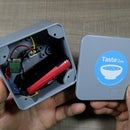Introduction: How to Replace the Rotary Encoder on a Car Radio
In this Instructable we will be replacing the rotary encoder from my friend's car radio.
He complained that the encoder is not working properly and that he is unable to adjust the volume on the radio. When turning, either there is no response in the volume or the volume will jump by a lot of steps or jump back to 0 even though he was increasing the volume.
So let's try to open it and see how we can fix it.
Supplies
- JCD8898 Soldering station - https://www.banggood.com/custlink/vmKdjiYfv7
- Rotary encoder module - https://s.click.aliexpress.com/e/_A6Dr06
- Low Melt Solder - https://s.click.aliexpress.com/e/_9fb8Xc
- Wire snips - https://s.click.aliexpress.com/e/_Ao21Iq
- Desoldering wick - https://s.click.aliexpress.com/e/_9ACmX4
- Desoldering pump - https://s.click.aliexpress.com/e/_AbCHSO
- Soldering helping hand - https://s.click.aliexpress.com/e/_9gyMA6
Step 1: Disassemble the Front Plate
The radio front plate can be removed from the radio body so when he brought it he brought just the plate.
This is not a new radio and immediately it was obvious that the plate have seen some abuse. Once I started disassembling it, I noticed that there are screws missing and there was only one left that seemed as it does nothing.
I removed the screw, and with a screwdriver, I gently pried the plate open to reveal the circuit board inside.
Bits of plastic fell off from inside that were part of the screw holders along with some of the buttons. So in order not to forget which button goes where I immediately put the buttons inside the front cover to their designated places.
With the PCB out, we can now start the procedure of removing the rotary encoder.
Step 2: Remove the Rotary Encoder
This step sounds extremely simple but it was anything but simple.
I started by first applying fresh, low melt solder to the joins on the encoder legs, and with that, I was hoping to reduce the melting temperature of the solder that the board was assembled with from the factory.
Since factories use unleaded solder, the melting point of it is much higher than the one we use when we solder components by hand.
The legs on the top of the encoder did accept the new solder nicely, but I was really struggling with the solder joins on the side that was also connected to the casing of the encoder that was made from metal. The metal body was pulling and dissipating the heat from the soldering iron and I could not remove any significant amount of solder.
When I saw no other way, I've resorted to using force and I used my snips to cut through the solder and the legs of the rotary encoder, so I could then melt just one of the sides and flip the encoder out of the board.
When doing this you have to be extremely careful as applying too much force might damage the PCB and rip the component out along with the copper traces from below.
Luckily, the encoder came out without any damage to the board and I now applied some new solder and I've cleaned the board with alcohol to remove the residue from the solder flux.
Step 3: Source a Replacement Rotary Encoder
With the encoder out, I tried to see if that encoder had any markings on it so I can search for a replacement part but there wasn't anything on it.
I went to my local parts store to see if I can find something that looked similar but they were out of encoders so my last resort was some of the encoders I had laying around from a previous video where I demonstrated how they can be used with Arduino.
I didn't know if they will work but it was worth a shot since they looked exactly the same in the footprint as the one I pulled out. A slight issue with this encoder is that it is a bit larger in the shaft than the one I pulled out but that should not be too much of a problem and we can shorten it later if needed.
So, I desoldered one from the module and I was off to replacing it on the radio PCB.
Step 4: Solder the Replacement Encoder
This part was much smoother than the removal. The only adjustment that I needed to do was to slightly bend the legs of the encoder so it sits on the SMD parts.
Unlike the original SMD version of the encoder, the replacement rotary encoder was a through-hole component so there was some fiddling involved with plyers but it was really easy to be done.
In case this repair didn't work and I had to remove this encoder, I didn't solder the case of the encoder to the PCB so I don't end up with the same issue as with the original. This should not be an issue as these connections are for mechanical strength only but it should stay just fine with the electrical connection as the frame also holds it in place.
Step 5: Assemble and Enjoy
In the end, what was left to be done was to assemble the front plate and since the buttons were already in the plate, this was just a matter of putting the PCB on top of them and adding the back cover.
When we tried the radio in the car, we were happy to see that the encoder worked as expected without missing any steps and the volume was adjusting properly. With that, this radio is now fixed and he can once again enjoy listening to music in his car.
I hope that you liked this Instructable and if you did, I'll invite you to check out my YouTube channel where I have a lot more repair videos as well as electronics projects and tutorials. Also, check out my other Instructables to learn more about Arduinos and electronics.
Thank you for reading!

Participated in the
Anything Goes Contest 2021













